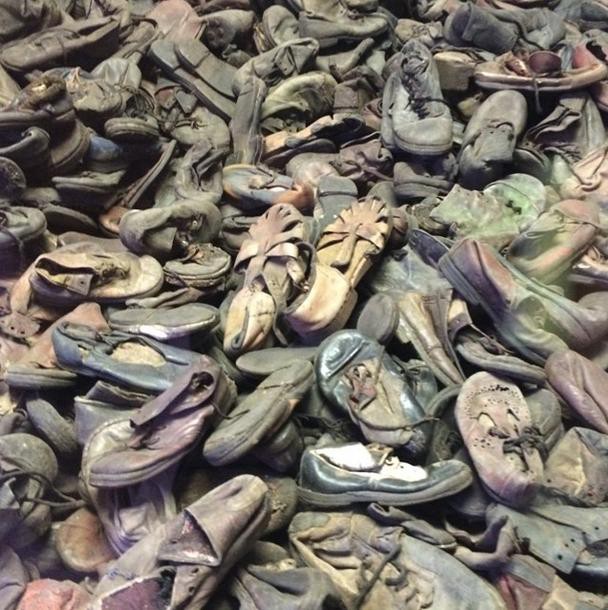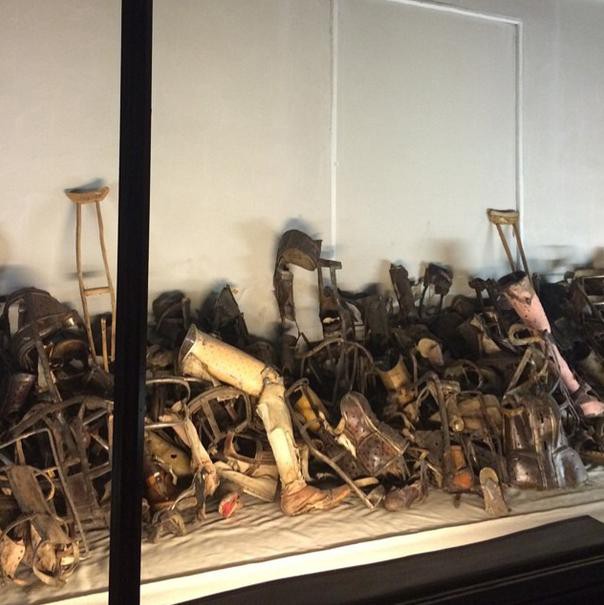Instagrams from Auschwitz
by Leah Finnegan

One of the exhibits at the Memorial and Museum at Auschwitz Birkenau in Oswiecim, Poland, is a room of human hair. The room has an odd purplish tint to it, cast by the climate- and light-control systems that slow the hair’s decay. A display case holds two tons of human hair from an estimated forty thousand people. “Please do not photograph the room of hair,” Pawel Sawicki, a press officer of the museum and my group’s guide, told us. “We don’t know exactly when it will all turn to dust.”
Photographing the hair might hasten its disintegration. But also, the museum balks at letting patrons take pictures of human remains; a crematorium on the grounds of Auschwitz I, one of three Auschwitz camps in the Oswiecim area, where seventy thousand corpses were burned, is also off-limits to cameras.
Still, many take pictures. Crowds gather in front of the ARBEIT MACHT FREI gate in waves, photographing it almost synchronously, because you can’t not take a picture of it. Some people pose under it and have their companions take their pictures. A few people take selfies. It’s weird. Where does the impulse to take a picture of the entrance to a place of horror come from? Because hardly anyone took pictures when it was happening? As evidence that you have visited?
Sawicki, who is thirty-three, runs the social media operation of Auschwitz. Its Facebook page, which he started in 2009, has a hundred and twenty-three thousand likes. It has been on Twitter for two years, and Instagram for a year and a half. Sawicki said that the impulse for Auschwitz to go social was to make these experiences educational for users, and he haunts these channels to make sure that happens. If you post a picture to Instagram and geotag it at the Auschwitz Memorial, Sawicki might leave a comment under the username “AuschwitzMemorial,” explaining just what you’ve shared a picture of.
I asked Sawicki how he felt about people taking selfies at the memorial. “I think that there is some universal tendency in us — people — to document,” he wrote to me in an e-mail. “And a self-portrait made in a place that you visit is a kind of a proof that ‘I was there.’ Family albums are full of such pictures.” He continued: “But there are photographs being made — not only selfies — with a different motivation. If they just use the site as a background, if they are meant to be funny or are disrespectful in any way or they are manipulative, etc. — then of course this is simply wrong.”
Among the Auscwhitz selfies, several people are wearing headphones. This is not because they are listening to music (probably), but because the tours, which most visitors go on, are conducted via audio, narrated by the guide.
Another photo shows a group of women huddling at a memorial wall in a courtyard where prisoners were executed by shotgun. There’s a comment in Thai on the photo, reminding us that the visitors to Auschwitz come from all over the globe. A photo of a man in silhouette, walking in the hallway of a converted barrack, is tagged with #vsco hashtags. It has twenty-five likes.

Many of the photos tagged at Auschwitz are repetitive. The iconic images seem to be piles of children’s shoes; the train tracks at the camp; suitcases, names handwritten on them in large letters, because the prisoners were told they would be returned after a shower; and a tangled mess of eyeglasses, which Sawicki told us were just organized to be “more orderly.”
I wondered how these photographs — amateur and otherwise — were fitting themselves into some new niche of a history of a place that reverbs with ghostly meaning. The many arguments against photographing and sharing images of Auschwitz and Nazi terror have gone on for decades. Janina Struk, a photographer and writer, argued in her book Photographing the Holocaust: Interpretations of the Evidence, “The Nazis took photos of their victims to humiliate and degrade them. Are we not colluding with them by displaying them ourselves?”
The ambiguity about atrocity photography exists behind the camera as much as in front of it. It’s an understanding among journalists that some reporters use cameras as a defense mechanism — a means of protection between them and an uncomfortable subject. George Rodger, who photographed piles of dead bodies at Bergen Belsen for LIFE magazine, later recused himself from taking photographs of atrocities. “The natural instinct as a photographer is always to take good pictures, at the right exposure, with a good composition. But it shocked me that I was still trying to do this when my subjects were dead bodies,” he said. “I realized there must be something wrong with me, otherwise I would have recoiled from taking them at all.”
If you’re tooling with a camera, you don’t have to pay total attention to, or interact in fully human manner with, whatever is occurring in front of you. Susan Sontag, in her essay “On Photography,” wrote that there “is an aggression implicit in every use of the camera.” I thought about this while touring the camp. Can we be aggressive toward remains? Can they be over-photographed? Or do we need to see them anew, from different perspectives, until they disintegrate, like the room of human hair?
The day after we visited Auschwitz I, Sawicki took our group to see Auschwitz II-Birkenau, which is about a mile away from the first camp. The heat was oppressive and forest-y Birkenau, built on a swamp, had given birth to a hungry colony of mosquitoes. It’s the worst place I’ve ever been to, even though there’s hardly anything there now but piles of bricks.
The ground is shifting at Birkenau, so the buildings are coming apart. We went into a wooden barrack that was built for fifty-two horses but instead housed four hundred men. We walked through the rooms where bodies were shaved and examined. We heard about how fat from burning bodies in open-air fire pits was saved and poured over the other bodies in the pit so they would burn faster.
Few photographs came out of the Auschwitz camps. Wilhelm Brasse, a prisoner at the camp, was used by officers for his photography skills; he took an estimated forty to fifty thousand entry portraits of prisoners before the SS decided it would be more efficient to tattoo prisoners. Members of the Sonderkommando, a squad of Jewish prisoners made to carry out grisly tasks such as corpse burning, took grainy photos with smuggled film. Many prisoners brought photographers from home with them; they were burned by the SS.
Sontag also wrote about the fragility and volatility of the photograph, “plagued by the usual ills of paper objects; they disappear, they become valuable, and get bought and sold; they are reproduced.” This is in large part no more. Of course, there are still some photos that are worth more than others. But a digital photo enters a modern canon of existence; it can automatically become sorted, indexed, and filed away into a new kind of history.
Before going to Auschwitz, some of the other journalists on my trip and I debated whether or not we would post photos of it to Instagram. Some people think there’s a line of decency, and a photo of Auschwitz crosses it.
But the impulse to continue photographing Auschwitz isn’t wrong. The number of survivors continues to dwindle, and time barrels on further and further from the event. We should keep posting — and sharing — photographs of places where horror has happened until these places inevitably disintegrate, even if the photo of such a place does not fit so neatly into a social network, where the crass language of the sharing community — “likes,” “hearts,” “selfie,” “re-gram” etc., etc., can denigrate the austerity of an image. If we use social media for only the happy or banal events in life — weddings, brunches, signs with terrible grammar — well, why bother?
In her last book, Regarding the Pain of Others, Sontag went further: “Narratives can make us understand. Photographs do something else: they haunt us.” Therefore, let us ask: What are you doing when you “like” a photo posted at Auschwitz? You’re not “liking” the Holocaust. You’re acknowledging that the history is real.
Leah Finnegan is a journalist. Support for her trip to Auschwitz was provided by FASPE.
Correction: The barrack housed men, not women.
